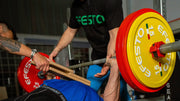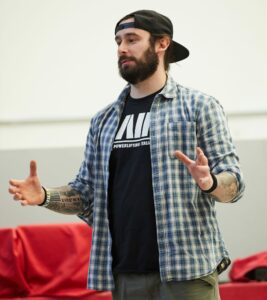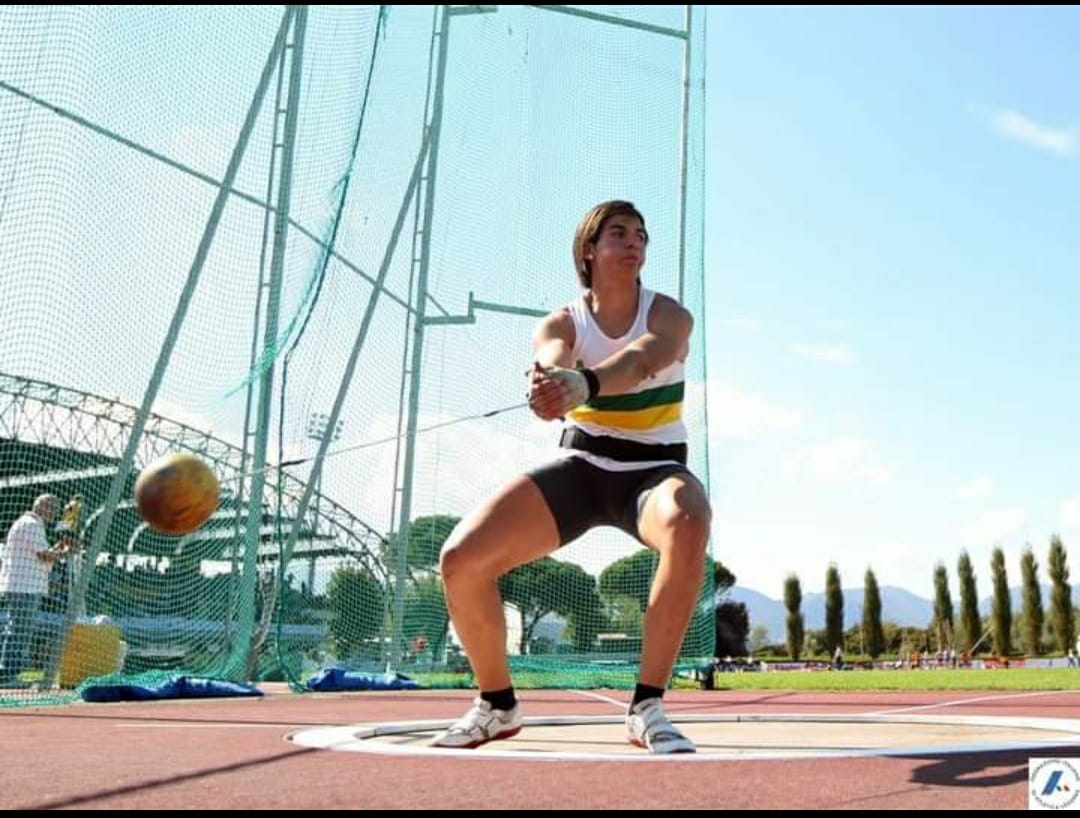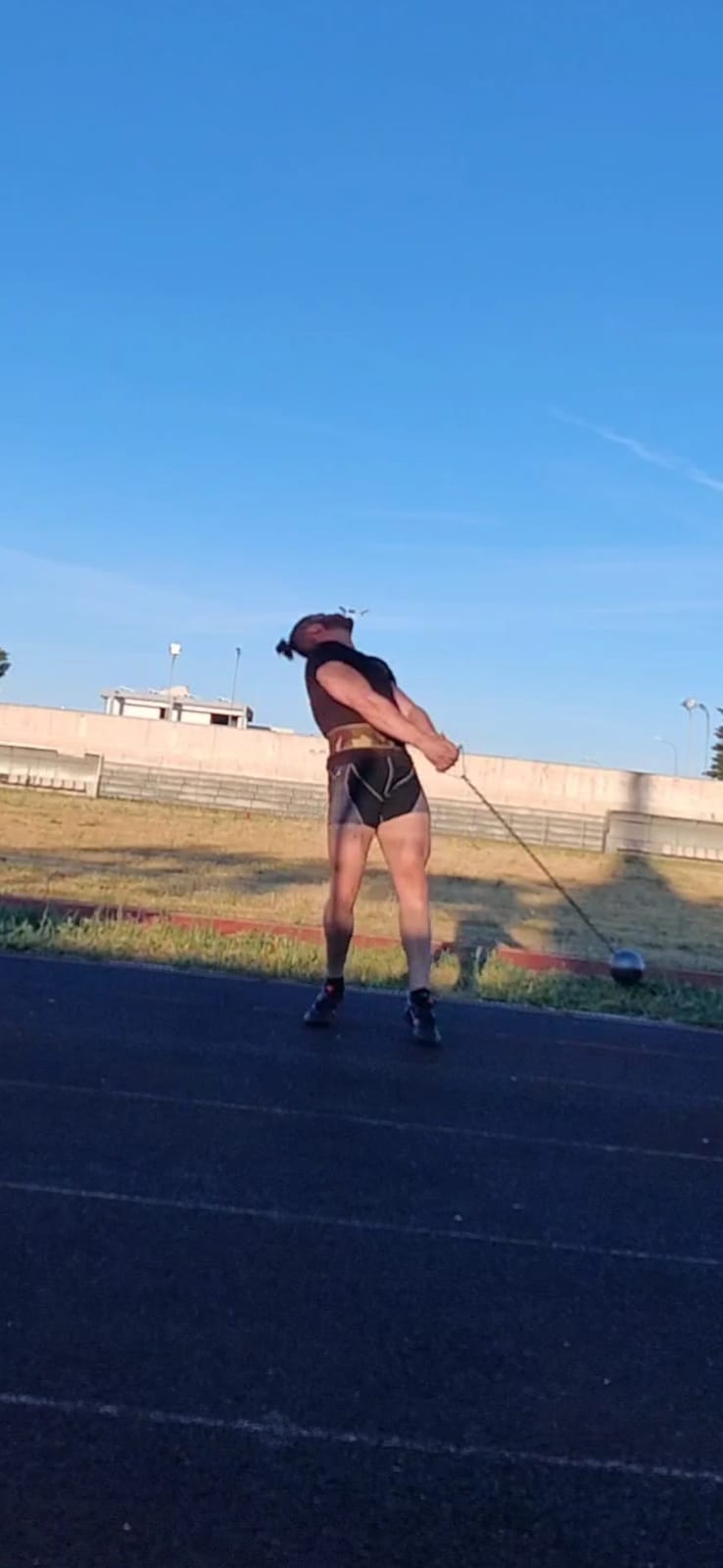

By Stefano Tintori
Teacher at the Italian Academy of Strength
Athletic trainer
Head Coach Bergamo Powerlifting
Graduated in Motor Sciences (UNIMI)
I would like to analyze a testimony from Carlo Calabrese, Elite Powerlifting athlete (Reigning Champion of the -93kg Senior category) with a past as a hammer throw competitor.
“I started practicing athletics (hammer throw) at the age of 15, and javelin throwing at the age of 19; in terms of competitive results, I obtained 9 bronzes, 3 silvers and 1 gold at the Italian championships in the various age categories and a call-up to the under-18 national team.

PAST RESULTS
My best performances in the hammer throw were: 56.98m (4kg cat. U16), 67.89m (5kg cat. U18), 64.80m (6kg cat. U20), 63.55m (7.260kg cat. Senior).
I decided to abandon athletics in 2018 (at the age of 24) due to various injuries including a tear in the left pectoral and an acute tendinopathy of the Achilles tendon. Now I have no longer practiced the hammer throw for almost 5 years, but every year to have fun and help my club I take part in a competition.
CURRENT RESULTS
The results obtained in recent years without carrying out specific training, but only powerlifting programming, have gone from a measurement of 52.80 meters done in 2018 (where it had been less than a year since I stopped training in throws, so certainly a good component of specificity weighed) at a measurement of 56.40 meters, obtained this year after almost 5 years of inactivity (old PB 63.55 meters obtained in 2017), and therefore further losing the residual specific ability compared to 2018.
What has happened in recent years? Have I improved my throwing technique? No, on the contrary it has gotten worse, given that the more years that pass, the more the automatisms of the gesture become lost.
Has my reactivity improved? No, the reactivity of the feet has worsened given the total absence of specific exercises.
Simply in recent years I have worked carefully on strength, improving all the various parameters and above all doing technical work that has allowed me to improve some muscle activations that I was not able to have before.
Even without directly training explosive strength, the parameters did not worsen, this means that all the weight work did not "slow down" me, on the contrary. This is not to say that technical and reactivity work is not useful, on the contrary, it is the basis for improvement, but that work DONE WELL with weights is equally important for improving performance.
METHODOLOGIES USED
In the years before powerlifting, my weight training sessions were mainly composed of 3 weekly sessions where I alternated Olympic weightlifting movements (pull and clean), squats, benches, pullovers, half squats, squat jumps and "special strength" exercises. that is, exercises with characteristics similar to the competition movement but with greater overloads than those used in competition.
As regards the training methodology, I used contrasting methods, especially in the period close to competitions, i.e. the alternation of a fundamental exercise such as the squat with a half squat Jump and plyometrics from a 60-70cm high box. While in the off season we tended to use methodologies based mainly on pyramids.
As regards the executions, the focus was mainly on "ALWAYS" developing the greatest speed and greatest explosiveness possible in all movements with overloads, thus often bypassing the muscular component of the exercises by shifting the work to the joints ; a clear example could be that of a bench press performed with a mat on the chest and a bounce on it to seek maximum exit speed.
Unfortunately, in many individual and team sports, weight training is still seen as "no matter what, just push as fast as possible" without having minimal control of the load and execution.
This, in addition to causing a high risk of injury in the athlete, takes away work from the muscle, therefore going against the objective that was set with the work carried out with overloads."
CONSIDERATIONS
First of all, it is necessary to contextualize Carlo's level of strength and above all specialization. 345.5kg of deadlift from the ground at a weight of 93kg is certainly an out of the ordinary performance and to get there a long journey of both conditional strengthening but above all coordination was necessary. Because the difference between going from 301.5kg (in the first deadlift competition in 2018) to 345.5kg (in the complete competition in 2022) without practically changing body weight means having built a more efficient and consequently more effective lift, in able to express more horsepower with the same displacement .

Great credit for this exploit can certainly be attributed to the improvement in the squat , a lift that was anything but simple for him and not even remotely intuitive considering his unfavorable leverage. Yet the kg on the barbell in the COMPETITION (because the kg in the gym are good just for Instagram) have risen dramatically, going from 230kg in 2018, to 250kg in 2019, up to the sensational 275kg in 2022, which on an anti-skid frame there are so many squats like his.
A technically very particular squat, with an unusual stance (at times extreme), which however its coach Giuseppe Gargiulo was able to manage best in terms of programming to make it respect the typical elements of an optimal squat, i.e. thrust line and muscular support in the hole .
Precisely this continuous search for quality of gesture has allowed Carlo to improve his squat and consequently also maximize his deadlift, but the really interesting thing is the improvement also obtained in the hammer throw without having practiced it at all. This was possible thanks to the management of the complex angles of his squat and the push timing of his deadlift, which had a direct transfer on the expression of general strength, both at the level of neural signal and intra/intermuscular coordination.
This is why in athletic training it is extremely important to do weights, but it is even more important to do them well!
Otherwise it really makes more sense to dedicate yourself to just practicing the specific competition gesture rather than trying your hand at improvised lifts or which, even worse, try to replicate motor patterns used on the field.

“But they are hammer players, they can't be as technical as powerlifters”
Ironically they must be even more so!
This is because if in PL competition at times, thanks to certain leverages, we find ourselves looking for a dynamic that tends to bypass certain points of the lift precisely because the final objective is performance on the platform in terms of kg lifted, in athletic preparation a similar choice would make no sense as it would drastically penalize purely muscular work.
So it's not about doing powerlifting in athletic training, but about doing squats, bench presses, deadlifts and moving the barbell in general in the correct way: which is very different!
Unfortunately Carlo is one of the many examples of how today athletic training with overloads of any competitive level still turns out to be a crude attempt at strengthening administered to athletes with incredible potential for growth and improvement, but condemned to mediocre/failure results for lack of technical coherence and solidity of teaching in the lifts done in the gym.
Do you want to find out how to program and manage the barbell in athletic training?
We look forward to seeing you at the Workshop "Weights in Athletic Training" on 18 September 2022 in Milan.

